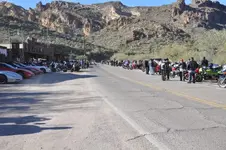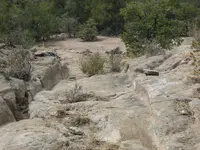What's a guess Joe ?
Are you saying the Tortilla Ranch Road/trail is not worn down to bedrock ?
All the trails I have traveled out there, as well as in other areas of Arizona have sections worn down and even into the bedrock.
The hiker websites are chock full of photos taken by enthusiasts in those mountains, with shots of much longer sections of well worn trails, especially on the west side of the wilderness. Like "hearts", they can be found everywhere out there.
The stones feature what everyone believes is a "well worn trail", with those relatively evenly spaced dimples representing obvious markers....except me. So that is what they expect to find and so look for. I was in that boat for a while, but didn't expect to find a wide or worn trail. Not where I was looking, an area far less traveled pre or post LDM, but with geology and terrain as well suited or better than most for hiding a large cache of value. It took a while, and a few false leads before I broke away from the pack. Such a cache would have little sign, if any, of human intervention I reasoned. A well worn trail would be a giveaway, like a neon arrow pointing to a burger stand. And someone clever enough to conceive what could be the most complicated series of maps ever created, would not leave behind so much as a trail of bread crumbs, let alone a highway littered with garish road signs and billboards. So he didn't, choosing instead to use a system of natural features which wouldn't be easily recognized or erased by man or the elements. Those he selected weren't mountains, canyons or rivers like those on the conventional maps everyone could read and follow, but much smaller features which would only be of use to someone who knew this to be the case.
Regards:Wayne








